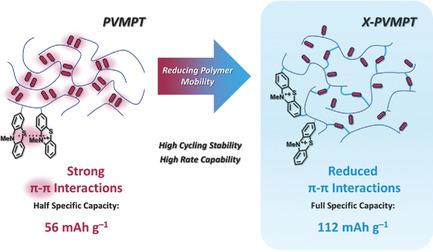当前位置:
X-MOL 学术
›
Adv. Energy Mater.
›
论文详情
Our official English website, www.x-mol.net, welcomes your
feedback! (Note: you will need to create a separate account there.)
Unlocking Full Discharge Capacities of Poly(vinylphenothiazine) as Battery Cathode Material by Decreasing Polymer Mobility Through Cross‐Linking
Advanced Energy Materials ( IF 24.4 ) Pub Date : 2018-10-14 , DOI: 10.1002/aenm.201802151 Fabian Otteny 1 , Martin Kolek 2 , Jens Becking 2 , Martin Winter 2, 3 , Peter Bieker 2 , Birgit Esser 1, 4
Advanced Energy Materials ( IF 24.4 ) Pub Date : 2018-10-14 , DOI: 10.1002/aenm.201802151 Fabian Otteny 1 , Martin Kolek 2 , Jens Becking 2 , Martin Winter 2, 3 , Peter Bieker 2 , Birgit Esser 1, 4
Affiliation

|
Organic cathode materials are a sustainable alternative to transition metal oxide‐based compounds in high voltage rechargeable batteries due to their low toxicity and availability from less‐limited resources. Important criteria in their design are a high specific capacity, cycling stability, and rate capability. Furthermore, the cathode should contain a high mass loading of active material and be compatible with different anode materials, allowing for its use in a variety of cell designs. Here, cross‐linked poly(3‐vinyl‐N‐methylphenothiazine) as cathode‐active material is presented, which shows a remarkable rate capability (up to 10C) and cycling stability at a high and stable potential of 3.55 V versus Li/Li+ and a specific capacity of 112 mAh g−1. Its use in full cells with a high mass loading of 70 wt% is demonstrated against lithium titanate as intercalation material as well as lithium metal, which both show excellent performance. Through comparison with poly(3‐vinyl‐N‐methylphenothiazine) the study shows that changing the structure of the redox‐active polymer through cross‐linking can lead to a change in charge/discharge mechanism and cycling behavior of the composite electrode. Poly(3‐vinyl‐N‐methylphenothiazine) in its cross‐ and non‐cross‐linked form both show excellent results as cathode‐active materials with variable specifications regarding specific capacity, cycling stability, and rate capability.
中文翻译:

通过交联降低聚合物迁移率,释放作为电池正极材料的聚乙烯基吩噻嗪的完全放电能力
有机阴极材料具有低毒性和可从有限资源中获得的优点,因此是高压可再充电电池中过渡金属氧化物基化合物的可持续替代品。其设计中的重要标准是高比容量,循环稳定性和速率能力。此外,阴极应包含大量的活性材料,并与不同的阳极材料兼容,从而使其可用于各种电池设计中。此处介绍了交联的聚(3-乙烯基-N-甲基吩噻嗪)作为正极活性材料,与Li / Li相比,它在3.55 V的高且稳定电势下显示出显着的速率能力(高达10C)和循环稳定性+,比容量为112 mAh g -1。钛酸锂作为插层材料以及锂金属均表现出优异的性能,已证明其可用于质量分数为70 wt%的全电池中。通过与聚(3-乙烯基-N-甲基吩噻嗪)进行比较,研究表明,通过交联改变氧化还原活性聚合物的结构可导致复合电极的充电/放电机理和循环行为发生变化。交联和非交联形式的聚(3-乙烯基-N-甲基吩噻嗪)均表现出优异的效果,因为其阴极活性材料的比容量,循环稳定性和倍率性能各不相同。
更新日期:2018-10-14
中文翻译:

通过交联降低聚合物迁移率,释放作为电池正极材料的聚乙烯基吩噻嗪的完全放电能力
有机阴极材料具有低毒性和可从有限资源中获得的优点,因此是高压可再充电电池中过渡金属氧化物基化合物的可持续替代品。其设计中的重要标准是高比容量,循环稳定性和速率能力。此外,阴极应包含大量的活性材料,并与不同的阳极材料兼容,从而使其可用于各种电池设计中。此处介绍了交联的聚(3-乙烯基-N-甲基吩噻嗪)作为正极活性材料,与Li / Li相比,它在3.55 V的高且稳定电势下显示出显着的速率能力(高达10C)和循环稳定性+,比容量为112 mAh g -1。钛酸锂作为插层材料以及锂金属均表现出优异的性能,已证明其可用于质量分数为70 wt%的全电池中。通过与聚(3-乙烯基-N-甲基吩噻嗪)进行比较,研究表明,通过交联改变氧化还原活性聚合物的结构可导致复合电极的充电/放电机理和循环行为发生变化。交联和非交联形式的聚(3-乙烯基-N-甲基吩噻嗪)均表现出优异的效果,因为其阴极活性材料的比容量,循环稳定性和倍率性能各不相同。











































 京公网安备 11010802027423号
京公网安备 11010802027423号